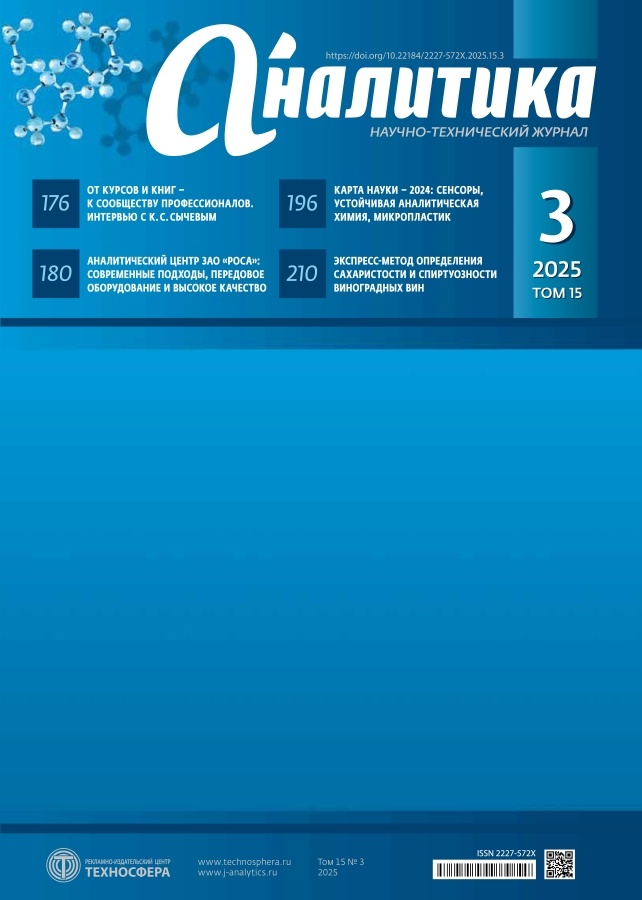Vol 15, No 3 (2025)
Мнение
From Courses and Books to a Community of Professionals
 176-178
176-178


Modern Laboratory
Analytical Center of JSC ROSA: Modern Approaches, Equipment and Quality in Analytical Control of Environmental Objects
Abstract
In the article, based on analysis of production processes and interviews with the heads and
experts of the ROSA Analytical Center, discussed the features of the technical base, the
specifics of quality management, personnel training, problems of import substitution of
equipment, and the practice of developing and implementing unique methods.
 180-191
180-191


Аналитика веществ и материалов
Science Map 2024: Sensors, Sustainable Analytical Chemistry, Microplastics
Abstract
This publication is the seventh in a series of articles containing the results of regular scientometric monitoring of analytical chemistry. The identified cutting-edge areas (fronts) of research are based on highly cited publications, grouped into clusters by frequent cocitation. In 2024, as before, there are many areas of research and development related to sensor devices used in medical diagnostics (COVID‑19, etc.), as well as in the analysis of environmental objects and food products. Attention to microplastics, an environmental pollutant, remains high. An extensive scientific field has emerged in which analytical methods are considered according to conditional criteria of colourfulness.
 196-202
196-202


Hybrid Organo-Mineral Sorbent Based on Silica Gel Modified with a Mixture of Polyvinyl Alcohol and Liquid Glass
Abstract
The article presents the results of research on the primary characteristics of hybrid or-ganomineral sorbents based on silica gel modified with a mixture of polyvinyl alcohol
and liquid glass (PVS : Na2SiO3). The relevance of the topic is due to the search for highly
effective sorbents for the development of analytical test systems and chromatographic
analysis. As a result of the work, the true density, strength, water absorption capacity, as
well as absorption capacity in relation to methylene blue and iodine were evaluated. It was found that an increase in the concentration of liquid glass in the modifying mixture leads to a decrease in the absorbing properties of sorbents in relation to both methylene blue and iodine. Analysis of the obtained experimental data allows us to classify the obtained sorbents as mesotype sorbents. The study revealed that the most effective is the ratio of polyvinyl alcohol and liquid glass 20 : 10.
 204-209
204-209


Refracto-densimetric Method for Determining the Sugar and Alcohol Content of Wines, Wine Materials and Fortified Drinks
Abstract
A rapid method for determining the sugar content and alcohol content of grape wines
with-out preliminary distillation of ethyl alcohol is proposed. The method is based on
measuring the refractive index and density of the sample and using the additivity principle of refracto-densimetric characteristics – the refraction intercept and specific refraction. The method can be used in laboratory conditions, and in the presence of pairs of immersion or flow refractometers and densimeters (densitometers) built into process tanks or product pipelines, it can be implemented in production. The method considers wines as pseudoternary mixtures of aqueous solutions of sugars (fructose : glucose 1 : 1), ethanol and organic acids (tartaric : malic 3 : 1 wt.). Other minor components of wines, close in refracto-densimetric characteristics to the acid benchmark, also implicitly contribute to the last component. The method has no concentration restrictions on the components to be determined. The trajectories of the fermentation process of sugar and grape must are shown on the Kurtz-Lorentz chemographic map. A simplified version of the method considers wines as binary mixtures of aqueous solutions of sugars and ethyl alcohol, in which case the composition of wines can be determined graphically using the Kurtz-Lorentz nomogram or calculated using a similar algorithm. The results of measuring wine samples show good agreement between certain composition indicators and those declared by producers.
 210-221
210-221


Determination of Trace Quantities of Copper in Food Products
Abstract
The interaction of copper (II) with an azo com-pound based on chromotropic acid – disodium salt of 2,7‑bis(azo‑2‑dihydroxy‑3‑sulfo‑5‑nitrobenzene)-1,8‑dihydroxynaphthalene‑3,6‑disulfonic acid (R) in the presence of diantipy-rylmethane (DAM) and ethylenediamine (ED) was studied. The influence of the concentration of reactants, time and temperature on the formation of mixed-ligand complexes was established, and the stability constants and the linearity range of the calibration graph were calculated. It was found that in the presence of excess ions of Cd (II), Zn (II), Mn (II), Co (II), Ni (II), etc., copper (II) can be selectively determined in the form of mixed-ligand complexes Cu(II)-R-ED(DАМ). The developed method for determining copper in the form of mixed-ligand complex Cu(II)-R-ED was tested in the analysis of food products (peas and buckwheat).
 222-228
222-228


Analytical Methods and Instruments
Development of a Charge-Discharge Method for Controlling Large-Sized Electrochromic Devices
Abstract
This article presents a new approach to controlling large-sized electrochromic devices based on the charge-discharge method. The developed method eliminates the problem of the edge effect and significantly equalizes the electro-optical characteristics of these products: 47 times compared to the galvanostatic control mode and 13.7 times compared to the pulse method. This, in turn, helps to increase the service life of large-sized electrochromic devices.
 230-234
230-234








